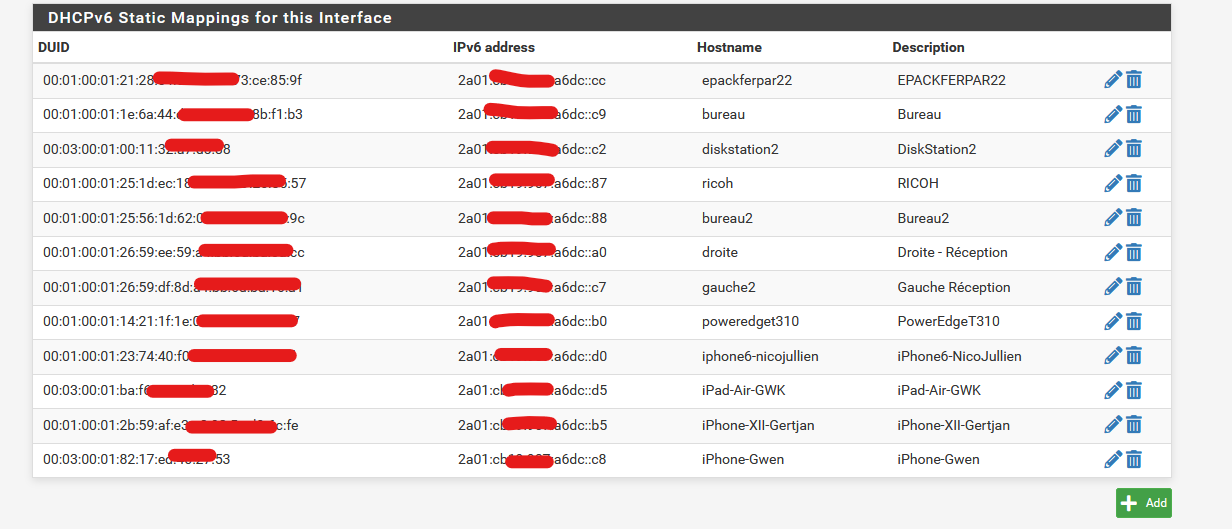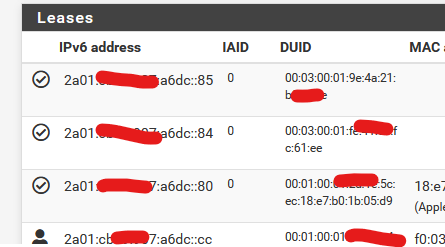DHCPv6 Static Assignments using IAID+DUID
-
It seems that there are plenty of topics about this subject from 10 years ago, but I wanted to figure out how this issue has evolved since then.
Basically I have a Mac mini in my network that uses both Ethernet and WiFi to connect to the same VLAN. The reason for that is that WiFi is needed for AirDrop and Ethernet is the main link for everything else. Everything works fine with DHCPv6 but the moment I want to assign a static IP for the Ethernet connection everything goes haywire.
Reason is that both interfaces have the same DUID with interfaces having a different IAID. But with pfSense using only DUID for static assignments, it gives the same IPv6 address to both interfaces, which you can imagine causes issues.
So my question is, can you do static assignments (in webUI or CLI) using a combination of IAID AND DUID?
-
@IonutIT
I'm doing just that for, dono .... close to a decade now :
So, when a device called bureau asks for a DHCPv6 lease, it will always obtain the same IPv6 GUA.
Note : my IPv6 /64 prefix never changes ...@IonutIT said in DHCPv6 Static Assignments using IAID+DUID:
Reason is that both interfaces have the same DUID with interfaces having a different IAID. But with pfSense using only DUID for static assignments, it gives the same IPv6 address to both interfaces, which you can imagine causes issues.
So my question is, can you do static assignments (in webUI or CLI) using a combination of IAID AND DUID?
Oh boy ...
Seeems pretty broken to me.My advise : Don't wait for apple to repair this (interface X using the same DUID as another interface Y on the same device).
( isn't their a solution for this like tweaking the MAC DUID whatever in a Mac ?)An end-user device shouldn't use two interfaces anyway at the same moment. That's just isn't "good" (to say the least) ...
What about the classic : throw in one or more APs in your network, and that will handle air stuff.
-
Using the same DUID for multiple interferences is actually normal. It’s supposed to be unique at the device level. That’s why you have Interface ID on top of that. That’s why Static assignment should be a combination of IAID as well as DUID.
If you see the DHCPv6 Leases page you can clearly see both the IAID as well as DUID, which is also why when not doing Static assignment you get different IPs on the two interfaces of the same device because IAID is different.
-
@Gertjan said in DHCPv6 Static Assignments using IAID+DUID:
An end-user device shouldn't use two interfaces anyway at the same moment. That's just isn't "good" (to say the least) ...
Using two is very common, as is switching primary interface when entering or leaving a sleep/power state. It is pretty basic stuff, even before all the esoteric or hybrid uses of interfaces that came with the more modern era.
-
@IonutIT said in DHCPv6 Static Assignments using IAID+DUID:
If you see the DHCPv6 Leases page you can clearly see both the IAID as well as DUID
Not being a MAC user (although : loads of iPads/iPhone) , I can't see any "IAIDs" :

These "0" listed don't mean a lot to me.
From what I know, the DUID is asked here, when setting up a DHCPv6 lease
Dono what happens if two unique interfaces are using the same DUID ... that's like (for me) that a device using a MAC asks an IPv4. Then another device, another NIC using the same MAC is doing the same thing.
I know, MAC is not DUID ..... but still.@RobbieTT said in DHCPv6 Static Assignments using IAID+DUID:
Using two is very common,
Upfront : I've nothing against it - but it's something I leave 'for the others'. (letting my ignorance protecting me here)
I've to add : I've a few PCs with a NIC and a wifi adapter - the latter is actually always turned of. -
@Gertjan said in DHCPv6 Static Assignments using IAID+DUID:
These "0" listed don't mean a lot to me.
That 0 indicates the interface. In my case 0 is Ethernet and 1 is Wireless.
-
So nobody has any clue on how you can achieve individual interface assignment?